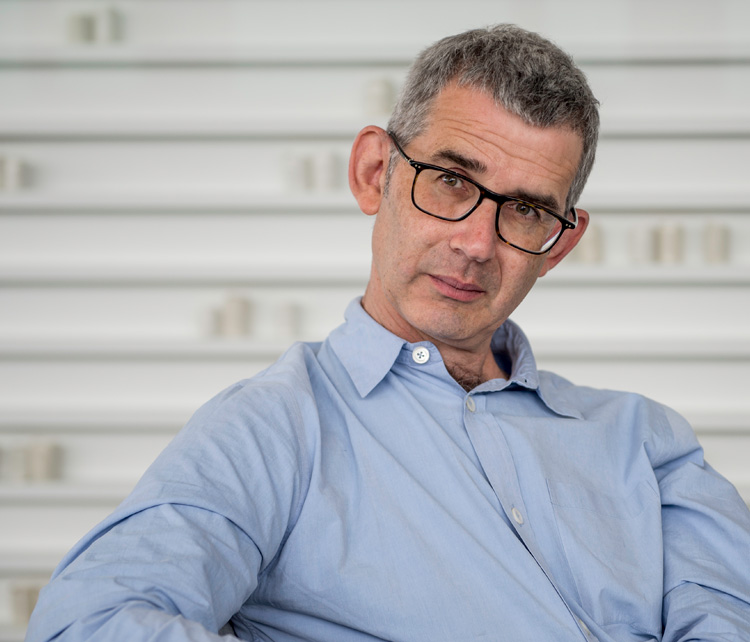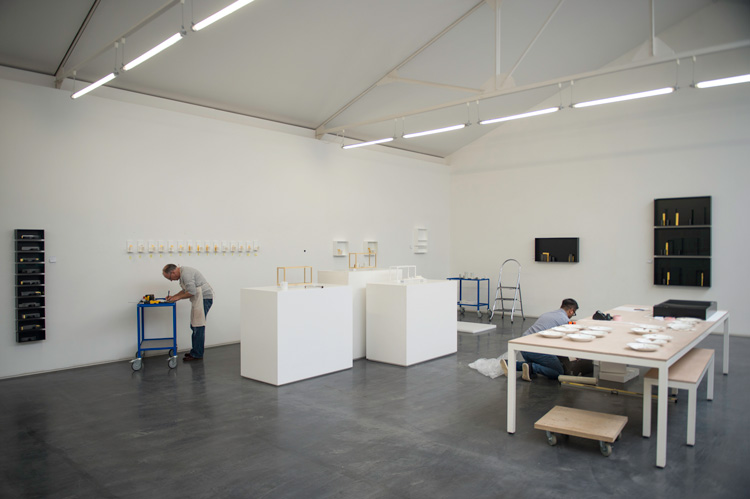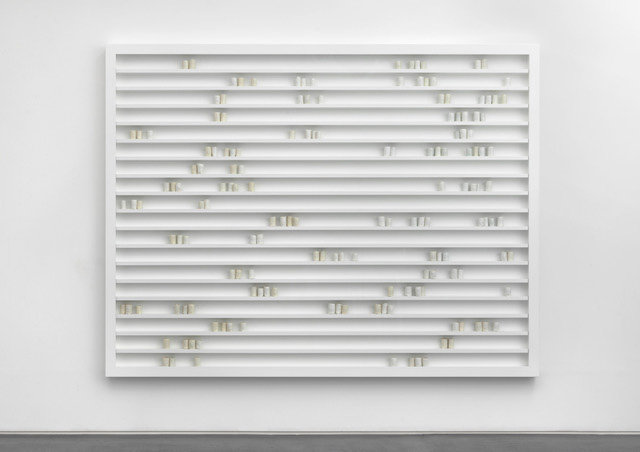
Edmund de Waal. Photo: Nick Howard.
by JANET McKENZIE
The British artist and author Edmund de Waal has had major exhibitions in Venice, New York and Berlin this year, each of which is the product of many years of work. Psalm was an exhibition conceived in two parts to coincide with the Venice Biennale: the Jewish Museum housed installations of porcelain, marble and gold that reflected the literary and musical heritage of Venice, while inside the Ateneo Veneto, De Waal constructed a small building to accommodate 2,000 books by exiled writers, from Ovid to the present day, all of which come from the artist’s Library of Exile. The latter installation will be on show in Dresden later this month, before travelling to the British Museum in London, and the books from the exhibition will be on show in Mosul, Iraq.
.jpg)
Edmund de Waal, the library of exile, 2019. Ateneo Veneto. Part of Psalm, an exhibition in two parts at the Jewish Museum and Ateneo Veneto, Venice. © Edmund de Waal. Courtesy of the artist. Photo: Fulvio Orsenigo.
The first contemporary artist to create a major exhibition for the Ghetto in Venice, De Waal said: “This is the project I have always dreamed of doing. It is about exile – what it means to have to move to another country, to speak another language. It brings new installations based on the Psalms, the poetry of exile, into some of the most beautiful spaces of the ghetto, the first time some of these spaces have been used for contemporary art. And my library for the Ateneo – 2,000 books within a porcelain-covered pavilion – will be the most significant sculpture of my life. It will be a new library reflecting Venice’s thousand years as a place of translation, a space to sit and read and be.”
.jpg)
Edmund de Waal, Psalm, I, 2019. Ateneo Veneto. Part of Psalm, an exhibition in two parts at the Jewish Museum and Ateneo Veneto, Venice. Porcelain, marble, alabaster, steel, wood, aluminium and plexiglass, 200 x 133 x 20 cm. © Edmund de Waal. Courtesy of the artist. Photo: Fulvio Orsenigo.
Psalm – Library of Exile refers to libraries as places of resistance and solidarity. The artist described the significance of the Venice exhibition: “The whole exhibition is called Psalm, where I am taking the idea of psalms as songs of exile and songs of place. Psalms identify another place, a place of aspiration to get to or a place of loss that is where you have come from. It was an extraordinary project because taking the idea of the otherness of exile obviously meant that I needed to work in the ghetto. I am not working with it as a melancholic place, which is how a lot of people view it, but one of possibility, because it was full of languages, of the culture of a community of exiles. The exhibition was years in preparation, years of negotiating with the authorities. There had never been any art exhibited in or around the synagogue. It was a big deal and a privilege, but then to place work in very special places was complicated. I ended up at the very top of the sukkah – a work that was really about the festival of Sukkot, the Feast of the Tabernacles, which commemorates the 40 years of wandering in the desert, celebrated by taking shelter and eating meals in a sukkah or temporary structure, often set up in the garden; it was a place of rest. The ghetto installation and theLibrary of Exile was huge and now it has started its travels to Dresden and to London.”
-2.jpg)
Edmund de Waal, sukkah, 2019, Jewish Museum, Sukkah Room. Part of Psalm, an exhibition in two parts at the Jewish Museum and Ateneo Veneto, Venice Porcelain, gold, steel, aluminium and plexiglass, 184.5 x 126 x 69 cm. © Edmund de Waal. Courtesy of the artist. Photo: Fulvio Orsenigo.
Library of Exile resonates with so many individual narratives and of situations of great cultural importance. It is he says, “a very simple idea, but shatteringly complicated to achieve. To make a new library that has at its centre 2,000 books by people forced to leave their home or who were exiled within it; to make a new library that has as its centre the idea that language is diasporic; then to make it truly resonant, make it truly rich; there are a thousand more books coming. The ghetto was a place of voices, of language in flux. Venice was also the centre of printing in Renaissance Europe.”
Fifteen hundred books came from the artist’s personal library, and others were donated from all over the world. “At the heart of the library is the idea that it is no longer mine. The great thing about a library is that, as soon as you have made it, people start to use it. In the period of just four months in Venice, all these incredible and amazing events took place: children’s groups, dance and musical events, a symposium.” An incredible 20,000 visitors attended Library of Exile in Venice, an exhibition that has evolved organically: “There is a notice in the Library of Exile that invites visitors to suggest further titles. The other thing that is very moving is that in every single book there is an Ex Libris plate, so you can pick up a book and write your name on the plate in a book by Joseph Brodsky, Osip Mandelstam or Thomas Mann, a book that means something to you. You can write your name on the plate. What it does is to establish emotional ownership of books of literature; you are not meant to write on a library book, but this enables us all to own literature. There are extraordinary aspects of it. The single most popular book in this exhibition, which hundreds of people have signed, is The Tiger Who Came to Tea, by Judith Kerr, and her story is phenomenal. We had to put extra plates in the book because it was so popular. Venice is a very good starting point, a crossroads, a meeting place, historically and culturally. The 16th-century Ateneo building near the Opera House was a meeting place for 200 years.”
The Library of Exile refers to individual lives, such as that of Kerr, who is also the author of When Hitler Stole Pink Rabbit. Her work conjures the lost childhoods of so many who died or fled persecution. De Waal’s choice of authors, which in turn constitutes a powerful body of literature, can be seen to refer to the cultural importance of libraries at a time when our government is closing them down; the Library of Exile refers as well to the lost and erased libraries of the world, from Nineveh and Alexandria to the recent destruction of libraries in Timbuktu, Aleppo and Mosul, and to the burning of books in Dresden by the Nazis in 1933. De Waal’s work thus operates on many levels and is conveyed through the elegant and poignant use of symbolic materials, particularly porcelain clay and gold leaf from which he creates haunting, minimal installations that evoke loss, a navigation of the void. De Waal’s exquisite installations and his moving memoirs assert the necessity for an ongoing conversation so that the horrors of the Holocaust are never repeated. His work encapsulates the dialogue in visual and literary terms that occupy the very heart of humanity.

Edmund de Waal’s studio. Photo: Nick Howard.
A visit to the studio of Edmund de Waal is a rare privilege between his trips to Berlin, Dresden and the US. A tour of the converted factory in south London indicates his unique methodology and the processes that characterise his practice. The office area and kitchen are central and as we move between the kiln room, large spaces where works are assembled, framed or placed in vitrines, packed for shipping around the world – there are two solitary work spaces – one for throwing pots and the other for writing – that conjure the dialogue that takes place between De Waal’s inner life and the outside world. His fragile porcelain installations are replete with references to history, literature, poetry and religious contemplation. Their impact is more powerful in the context of his writing and scholarship, the intellectual courage borne of his Jewish family’s survival. In both the written narrative and the manipulation of an ancient craft, he weaves stories with great tenderness and originality. There is a side room in De Waal’s factory in which a single work hangs. It evokes the ritual purpose – in architectural terms – of a side altar within a church or cathedral. Indeed, the movement through the workplace is a mesmerising encounter that alludes to liturgical progression and it is hugely inspiring. Although exquisite and refined, De Waal’s work inspires a communal response, a participation in the sacred, a quiet passion to bring about change.

Edmund de Waal, a place made fast, 2014. Porcelain, wood, aluminium and glass. © Edmund de Waal. Courtesy the artist. Photo: Mike Bruce.
Our conversation took place in the writing room, where the artist sat in front of a large installation, made up of small porcelain vessels on shelves behind glass. The shelves suggest a musical score as well as alluding to sentences, to dialogue. These are works that require time where the viewer is included. The 55-year-old artist’s life-long obsession with the very stuff of clay, the methods employed to throw or carve or pinch, endows each vessel with connectivity to the wider world. En masse, his tiny porcelain vases establish individual objects within systems that allude to thought, to silence and to being human. Shards of broken porcelain, on a marble plinth, gold, steel, the delicate oblong forms create sculptural configurations of such beauty that evoke his vocation where he enjoys “the long-term love affair with art, with light and how you move between forms”.
-2.jpg)
Edmund de Waal, tehillim, 2018, Jewish Museum, Canton corridor. Part of Psalm, an exhibition in two parts at the Jewish Museum and Ateneo Veneto, Venice. Porcelain, gold, marble, aluminium and plexiglass, 28 x 1,164 x 10 cm overall. © Edmund de Waal. Courtesy of the artist. Photo: Fulvio Orsenigo.
Where groups of small vessels occupy a shelf that is mostly empty, there is a sense of a pause, a reflection. The White Road: A Journey Into Obsession (2015) is an account of his pilgrimage to the three most important sites in the history of porcelain: Jingdezhen in China, Dresden and Cornwall. De Waal infuses porcelain clay with a sense of alchemical mystery. The book seeks to define the meaning of white. Drawing on a plethora of sources, imbued with personal lives and passed from generation to generation, he cites Emanuel Swedenborg (1688-1772) whose treatise, Heaven and Hell (1758) was translated by the porcelain manufacturer and Quaker minister William Cookworthy (1705-80): “White is truth. It is judgment; white brings us all into clarity. White reveals. White is revelation itself. White is grief and it is also hope.” The colour white can be seen to symbolise spiritual purity and a retreat from the vanities of the material world. In De Waal’s career, the humble material of clay is brought to life through centuries of knowledge, but also with the faith of the alchemist.
.jpg)
Edmund de Waal, that pause of space, 2019. Porcelain, gold, alabaster, aluminum, and plexiglass, on view in the North Hall, 22 13/16 × 29 15/16 × 11 in. © Edmund de Waal. Courtesy the artist and The Frick Collection. Photo: Christopher Burke.
Two further exhibitions this year, assert De Waal’s status as artist and author of rare sensibility. Elective Affinities: Edmund de Waal at the Frick Collection is an installation of sculptures made of porcelain, steel, gold, marble, and glass, displayed alongside works from the permanent collection. It is the first exhibition of a contemporary artist in the Frick’s permanent galleries. And at the Max Hetzler Gallery in Berlin last month, in A Sort of Speech, De Waal took the words of the Swiss writer Robert Walser (1878-1956) and inscribed them in pencil, gold leaf and compressed charcoal. Walser’s adoption of an obsessive form of notation following a breakdown, which he described as a “pencil method”, has long had great significance for De Waal.
.jpg)
Edmund de Waal, an alchemy, 2019. Porcelain, steel, gold, and plexiglass, on view in the Library, 18 1/8 × 21 5/8 × 16 9/16 in. © Edmund de Waal. Courtesy the artist and The Frick Collection. Photo: Christopher Burke.
On 6 November 2019, following the donation by the De Waals of the Ephrussi family’s archive to the Jewish Museum in Vienna, De Waal’s family held a reunion at Palais Ephrussi, with the exhibition: The Ephrussis: Travel in Time at The Jewish Museum, 80 years since they were forced to leave Vienna in 1938. The event celebrated the Austrian government’s new law (ratified in September 2019) to extend citizenship to those forced to flee the country during and after Hitler’s Third Reich and their descendants. The decision follows a huge rise in inquiries from descendants with British nationality wanting to secure citizenship of a European country before Brexit. Previously, only Holocaust survivors were able to apply. Restitution and the recording of stories of such gravity with global ramifications, is amplified in De Waal’s career, in which he straddles the worlds of writing and ceramics. His masterpiece, The Hare with Amber Eyes, A Hidden Inheritance (2010), has sold 1.5m copies worldwide. The artist’s intention is to create silence and to prompt in the viewer, a capacity “to slow down”. Inevitably, his work ascends to the condition of prayer, uniting souls irrespective of culture.
• The Ephrussis: Travel in Time is at the Jewish Museum in Vienna until 8 March 2020.
Edmund de Waal: Library of Exile is at the Japanese Palace, Dresden, from 30 November 2019 to 16 February 2020.
Elective Affinities: Edmund de Waal is at the Frick Collection, New York, until 17 November 2019.